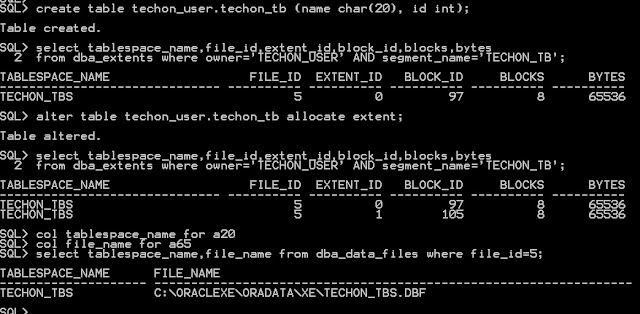Database is combination of physical and
logical storage structure. pictorial view will look like below figure.
DBA will be able see
both views but for developer physical view is unknown and it won't affect its
functionality as it whether it is moved to re-organized.
we can see there is one
dotted line between datafile and segment, because its non -direct relationship
as tablespace contains many segments and same is made up of many datafiles.
Logical View
Tablespace: Tablespace is collection of number of segments which may contain
one or more datafiles depending on type of tablespace i.e. normal or smallfile
will have number of datafiles and bigfile tablesapce will have single datafile
with huge maxsize. tablespace names are unique in database.
we can query the tablespace names using dba_tablespaces view
SQL> select
distinct tablespace_name from dba_tablespaces;
TABLESPACE_NAME
------------------------------
SYSAUX
TEMP
USERS
SYSTEM
UNDO
Segment: This
entity represent any database objects say table, index that store data
and hence required space in tablespace. Many segments will combine in
single tablespace.
Extent: Managing space one block at a time is difficult task
so oracle blocks are grouped together to form extent. Extent is consecutively
numbered Oracle Blocks within on datafile. Every segment is consisting of number of extents.
Oracle Block: This is
smallest logical unit in the oracle database. size of the oracle block is fixed
for a tablespace, you can say it is fixed across all tablespace in a database,
generally it is 8 KB. There could be number of rows in single block, but when
session request for row it will fetch whole block from disk into db buffer
cache, similarly when row or column is changed in db buffer cache, the DBWn
will write whole block back into datafile from which it came, overwrites
original one.
Size is defined by DB_BLOCK_SIZE
which can never be modified once database is created.
Physical view:
Datafile: This is physical entity made up of number of operation
system blocks. structure between datafile and operating system block totally
depends on operating system file system.
for example -
MS-DOS FAT file system- file size
upto 4GB only.
Operating System Block : unit of I/O for file system. operations wise it looks
same as oracle block, if process wants only one byte from disk but I/O will
have to read while os block. default operating system block size is 512B to 1KB
depending on devices used.

Identifying physical location of segments extents
First commands create new table
techon_user.techon_tb
Third query allocates another extent to segment. next query shows new extent
number 1 though first is not full.
Third query allocates another extent to segment. next query shows new extent number 1 though first is not full.
Comment below in case additional information is required.




0 comments:
Post a Comment